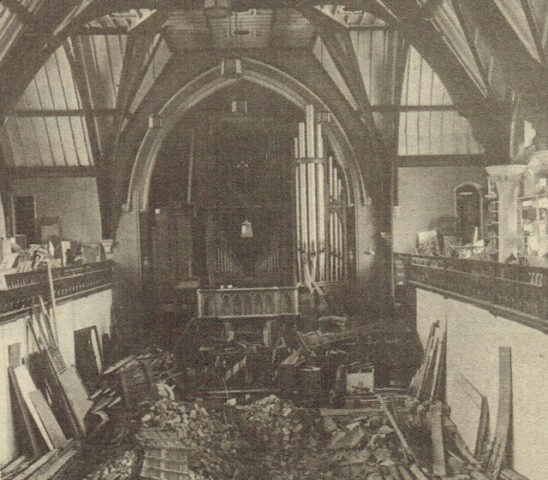The first article in our new series on Church Buildings which have changed their function.
In 2022 we will be looking at some buildings, specifically churches, which have changed their function or have been knocked down and replaced, usually by residential accommodation of one type or another.
In this first article we explore some of the issues surrounding the redundancy of such buildings, consider their fate and the place of such buildings in the historical landscape in which they are/were situated.
Who needs old buildings?
Hornsey Historical Society (HHS) was founded in 1971 at a time, locally and nationally, when many developers felt that old buildings hampered a ‘modern’ look being given to the new built environment. It is said that in the 1960s and 70s more damage was done to London’s architectural environment than had been achieved by the bombing during the Second World War. The rebuilding of Euston Station in 1962 to serve modern rail travel demands led to the demolition of the Euston Arch (1837) in front of the station, considered ever since as one of the worst acts of architectural vandalism in the UK. Conservation issues have been an important focus of the Society ever since.
The background
The fields of the rural, sprawling, ancient parish of Hornsey steadily disappeared during the second half of the 19th century under bricks and mortar. Urban development gathered apace in Stroud Green from the 1860s and by the end of the 1880s street upon street of houses and buildings such as churches, libraries and pubs, had replaced the fields, with the same happening to Muswell Hill in the north of the parish from the late 1890s. The pace of change was startling given that builders had no cranes, mechanical diggers and excavators, or safe scaffolding. Hornsey’s local government from 1867 to 1894, the Local Board (of Health) employed building inspectors and ensured, under the watchful eye of Chairman Henry Reader Williams, that all buildings met the required standards.
Middle class preferences
Much of this building development was for middle class families drawn to these new suburbs by the lure of ‘Healthy Hornsey’, by the open spaces such as Highgate Wood and Queens Wood, by the commodious houses which accommodated the family and at least one live-in maid, and by the amenities provided such as churches, private schools, fire stations, police stations, libraries and shopping parades where all the needs of the household could be met. Many of these services were provided municipally but the new house owners were God-fearing folk and looked for a church of their denomination in the immediate area. The Church of England kept pace as best it could with demand, building temporary churches initially called ‘tin tabernacles’, to be replaced often by ‘off-the-peg’ buildings erected wherever an available site in the community was located
The Nonconformist denominations were particularly strong in Hornsey’s suburbs, particularly the Wesleyan Methodists, the Baptists, Congregationalists and Presbyterians. Their churches made a statement. They were buildings of prestige and influence in their communities with ministers to match, large enough to accommodate 700 – 1,000 people, often occupying a corner plot so as to be more visible and accessible and rooms for activities and meetings were part of their construction.

A few examples are: New Court Congregational Church, Tolllington Park, Stroud Green, the Presbyterian Church in Highgate, Ferme Park Baptist Church and Park Chapel (Congregational) in Crouch End, Holly Park Methodist Church on Crouch Hill almost next to the large Presbyterian Church and the Presbyterian Church in Muswell Hill.
Changes over time
Two phenomena occurred in the second half of the 20th century to alter this situation – the population shrank as birth control methods became common and two world wars led to religious scepticism and a decline in church attendance. In the late 1960s another factor impacted on local Congregational and Presbyterian churches and their memberships. In 1972 the Presbyterian Church of England and the Congregational Church in England and Wales joined as The United Reformed Church, although about a quarter of English Congregational churches chose not to do so as the independence of each congregation had been their hallmark since the 16th century.
Inter-denominational co-operation between the churches had always been strong but this new union led to the redundancy of churches. It was not practical or necessary to maintain two buildings in the one area and a decision had to be made as to which church to use for the now-united Presbyterian and Congregational flocks.
The issues
Church redundancy raised not only many questions but highly charged emotions as well as the issues were debated and churned over, often over a long period of time:
- What would become of the rejected building?
- Was a church building different from any other once its function as a place of worship was discarded?
- Were there alternative uses for the building which are acceptable such as such as a library, theatre or concert hall?
- Were there uses for a church building that are unacceptable, for example car showroom, builder’s merchants, pub?
- Would conversion to another purpose harm its character?
- Was the building of architectural merit?
- Did it have a visual impact in its surroundings?
- What about noise pollution, influx of outsiders to the new facility, traffic noise and parking facilities?
Often the church leaders had different ideas from the local residents. Nowhere in the district of Hornsey was the impact of the formation of The United Reformed Church felt more acutely than in Muswell Hill where the new denomination’s decision to retain the Congregational Church in Tetherdown and to sell the Presbyterian Church building in the Broadway led to years of high emotion, argument and demonstrations. This important example will be the focus of the next article in this series.
Image credits
Image of Park Chapel, Hornsey Journal 25.09.81 – courtesy of Archant.